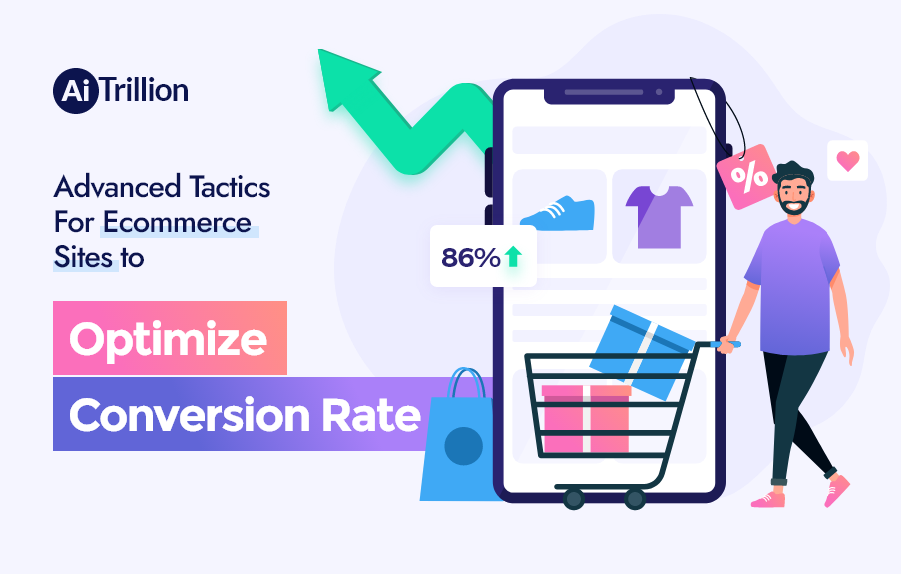Your customer behavior and their actions on your website help you make their paths towards purchasing smooth and hurdle-free.
In this guide, we’ll discuss some of the tried-and-true strategies that Shopify store owners can use to improve conversions of their eCommerce store.
Before discussing how to optimize your store conversion rate, let’s discuss what is eCommerce conversion rates?
What is the eCommerce conversion rate (CVR)?
Google has defined eCommerce conversion rate as the “ percentage of visitors to your website that complete a desired goal (a conversion) out of the total number of visitors.”
Formula
[number of transactions] ÷ [number of visitors or sessions] x 100 = CVR
A high conversion rate reflects successful marketing and web design. It means your visitors love what you are offering, and they’re easily able to get it!
Your conversion rate may vary based on what goal you set for your marketing campaigns. You may have actions you’d like them to take, such as signing up for a newsletter or joining a loyalty program. In such cases, CVR is used to help you evaluate the effectiveness of specific promotions or sales.
So, in simple words regardless of your goal, determining your conversion rate is about examining the overall health of your site, your products and brand as a whole, and your marketing and customer service.
What are the typical conversion rates in eCommerce?
According to real-time market data from IRP Commerce, the average conversion rate as of July 2021 is 1.81%, but it is usually ranges between 2% and 2.5%.
The conversion rate vary based on a discrepancy between countries, seasons, industries, devices, and others. For example, based on the “IRP Commerce report the average conversion rate as of July 2021 is 1.81%, but it usually hovers between 2% and 2.5%”.
For each Shopify seller, the average CVR can fluctuate based on several factors, including the types of product you sell, the cost of your products, and your average order value (AVO).
- Arts and crafts: 3.39%
- Baby and child: 0.89%
- Fashion clothing and accessories: 1.63%
- Food and drink: 1.58%
- Health and wellbeing: 3.05%
- Home and giftwares: 0.99%
- Pet Care: 2.85%
- Sports and recreation: 1.37%
Advanced strategies for improving eCommerce conversion rate
Here we have mentioned some proven tactics to improve the eCommerce store conversion rate.
1. Use analytics data to set benchmarks
To improve your conversion rate, first find out your current conversion rates along with other worthy metrics like AOV, and customer lifetime value (CLV).
To find out your customer purchasing pattern and visitors’ behavior, you’ll need to understand your website’s analytics. It will help you know how customers move through your website, activities they performed from the moment they land on your eCommerce store until they reach the checkout. This is also referred to as conversion funnel optimization.
For complete conversion funnel analysis, you need to deep dive into analytics reports which can be possible effortlessly with an AI-powered eCommerce marketing platform. The platform will help you accurately track your visitor’s activity and determine how you’re going to track the performance of your market campaigns.
2. Get the right tools to discover where your customers are getting abandoned
The one right tool can transform all your marketing hurdles. That’s why your first step in conversion rate optimization should be taking a holistic and user-centric approach to figuring out
eCommerce marketing platform that can help you design marketing campaigns that really attract people to move to your website.
A platform like AiTrillion helps you design marketing campaigns that really worth clicking. Its analytics helps you identify issues so that you’ll be able to see what’s causing visitors to abandon their carts or leave your store altogether.
3. Optimize the speed of your site
Your site’s speed plays an important role in conversion rate. If your product images and pages take time to load then you are leaving money on the table. “In 2006, Amazon reported that just 100 milliseconds of extra load time cost it 1% of sales—the equivalent of over a billion dollars”.
One of the most common reasons for slow website speed is installing multiple Shopify apps. In order to boost sales and attract more traffic to a website, store owners tend to install multiple apps which not only fetch the customer data but also slow down the store speed.
Your store doesn’t need multiple apps to engage, retain and nurture your customers. Only one automated eCommerce platform can help you to achieve this.
With AiTrillion brands saw dramatic improvements:
- 14% increase in revenue
- 19% increase in conversion rate
- 11% decrease in average page load
- 35.95% decrease in average server response time
- 5% decrease in bounce rate
4. Ensure visitors to your website feel safe
Covid-19 has changed the landscape of eCommerce. There were various shoppers who bought something online for the very first time ever due to the pandemic. However, this new with these new customers came an intensified fear of scams and fraud. Based on research, 67% of all consumers said they think online shopping during COVID-19 has put them at a higher risk of scams.
Data breaches not only come with financial implications. Phishing, viruses, and stolen information can harm your brand image and affect your conversion rate.
That’s why it’s important to show your customers that your online store is trustworthy. Using apps that don’t do much for your customer engagement instead increases the threat of data breaches.
Protection strategies including the use of a trustworthy marketing platform, mitigating bots, backing up your store; and employing the use of eCommerce security apps and tools.
5. Improve your navigation
Anything that affects a shopper’s journey on your website can lower down the conversion rate. You should always make your website navigation smooth, intuitive, and seamless, and it should help customers to buy the products hassle-free.
The two most important spots where smooth navigation plays a crucial role are on the product point of your site and the checkout page. Still, some of the companies don’t display product categories in their main site navigation, which results in various navigational issues for customers.
6. Use eCommerce SEO best practices
Do you know “74% of consumers research and compare products via search engines before completing a transaction”. ~ Forrester
SEO has a huge impact on CRO. This helps in improving your site visibility and lets more people know about your brand. SEO doesn’t only get visitors to your site but it also helps get them to stay there.
To improve your search engine rankings, write your product descriptions with keywords. Do not forget to implement other SEO strategies like optimizing product images, improving your page loading time, and using analytic tools to monitor and use the most appropriate SEO tactics for your store.
7. Make your product pages actionable
Make your product page actionable so that if the customer likes something he/she can buy directly from the page. Suppose if a customer has a product and is considering putting it into the cart. What if they can’t find a sales associate to help them? Or what if they want to buy a product that has reviews? In such cases, customers head over to the competition to make their final purchase or sometimes they put the products in their cart and discover the same product in other stores.
Visiting a product page gives a customer convenience to make the purchase, but any friction can change their mood and make them leave the store.
The avoid the situation create more actionable product pages. If your customers aren’t tabbing Add To Cart, it might be time to use user testing to see the page through your customers’ eyes.
8. Leverage social proof
Customer reviews create a significant impact on whether or not a customer buys a product from a particular store. If an eCommerce store doesn’t have product reviews, customers will hardly trust their products and then they will go elsewhere to find desired products.
If you have genuine reviews on your site, customers will be more likely to buy from your store. AiTrillion allows you to automatically ask customers to review your products within a fixed time from their purchase.
Obviously, you don’t want to ask too early because they won’t have had enough time to enjoy the benefits of the product. Asking for reviews is one step in a series of post-purchase emails.
“Product with five reviews is 270% higher than the purchase likelihood of a product without any reviews, while purchase likelihood increases by 15% when consumers are exposed to reviews written by a verified buyer versus an anonymous review”.
9. Create discounts and offers for website visitors
If you want to improve your conversion rate quickly, start offering a discount code. Based on research Shopify store owners make more sales when coupons are used. Offers such as free shipping, percentage off, free product, and others can also be an important factor in converting a website visitor into a sale.
In the past few years, the Loyalty program has been proving as an effective technique to engage and retain customers. Using a Loyalty Program with Email Marketing increases the open rate and also improves the conversion rate.
Offering discounts and promotions via email, popup, web notification, and SMS campaigns help improve CVR. Particularly it helps in abandoned carts recovery.
Loyalty Program also helps you build social proof when people refer your brand to their friends and relatives online. It opens up a new door for customers to engage with your brand other than your website and products.
With AiTrillion, you can create a personalized loyalty program that matches your brand value and vision. Also with AI-powered analytics, you will have a solid understanding of how successful your referral program is or if you need to make adjustments in order to make it effective.
10 Improve your customers’ post-purchase experiences
Post-purchase experience is a key element for optimizing a conversion rate. Start sending welcome campaign emails, as they have a particularly high open rate as compared to other campaigns.
You can also send thank you message after completing the purchase with some discount coupons that they can use in their next purchase.
Wrap Up
All these proven techniques help in optimizing the conversion rate of an eCommerce store. However, it completely depends on the store owners how intelligently they have implemented the above-mentioned strategy. If you have any doubts or any further questions regarding conversion rate and how to increase sales, you can schedule a call with our Shopify experts.

Drive sales with AiTrillion
Grow your eCommerce business with marketing automation and actionable analytics



Leave a Comment
You must be logged in to post a comment.